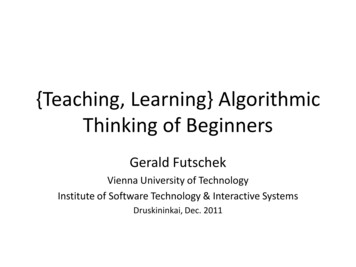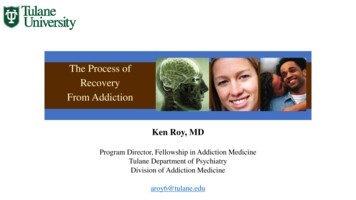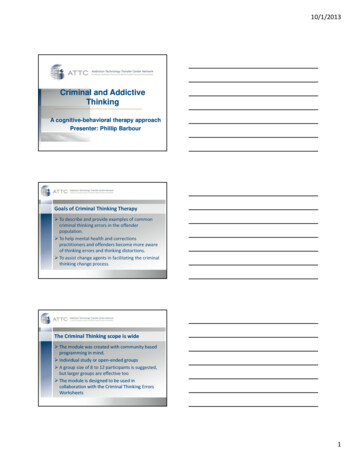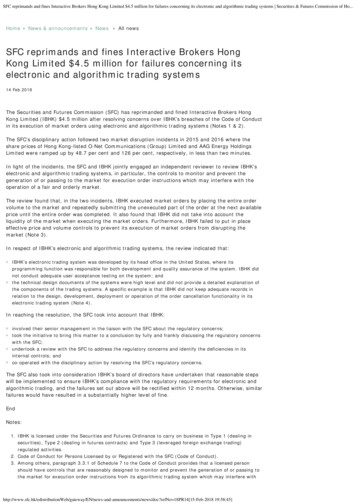
Transcription
{Teaching, Learning} AlgorithmicThinking of BeginnersGerald FutschekVienna University of TechnologyInstitute of Software Technology & Interactive SystemsDruskininkai, Dec. 2011
Austria and EU
Vienna University of Technology
Vienna University of Technology 20000 students Faculty of Informatics: 6000 students (5 Bachelor, 7 Master, Teacher Edu.,PhD) 1000 beginners per year
Algorithmic Thinking Find a path in a maze
Let‘s do it in real world!Underground labyrinth in Buda (Budapest)
Algorithmic ThinkingFind a path out in absolute darkness
QuestionsAlgorithmic Thinking––––What is it?Who should know?Why to learn?How to learn?How to start learning?How to motivate beginners?What tools?How much effort (ECTS)?Beginning withalgorithms/programming– What are the problems?– Why it is complex?– Why are some successfuland others not?
Algorithmic Thinking – What?From: Donald E. Knuth Algorithmic Thinking and Mathematical ThinkingPage 180 of 170-181, The American Mathematical MonthlyVol. 92, No. 3, Mar., 1985.
Algorithmic Thinking - NRC Being fluent with information technology. National ResearchCouncil Committee on Information Technology Literacy. (1999).Washington, D.C.: National Academy Press." general concepts of algorithmic thinking, [include] functionaldecomposition, repetition (iteration and/or recursion), basic dataorganizations (record, array, list), generalization andparameterization, algorithm vs. program, top-down design, andrefinement. Note also that some types of algorithmic thinking donot necessarily require the use or understanding of sophisticatedmathematics.“Lawrence Snyder: programming is algorithmic thinking in a tangibleform. Chairman of NRC Committee on Information Technology Literacy,From The Chronicle of Higher Education, Information Technology, issuedated May 5, 2000
Algorithmic Thinking - CoursesAlgorithmic Thinking (COMP 182)Rice University, Houston, TexasThis course introduces algorithmic thinking as adiscipline for reasoning about systems, taming theircomplexities, and elucidating their properties.Algorithmic techniques, along with their correctnessand efficiency, will be taught through reasoning aboutsystems of interactions, such as markets, that areubiquitous in our highly connected world.Pre-programming: Algorithmic Thinking (Course #600.106 )Problem Solving and Programming PracticesJohns Hopkins University, Baltimore, MarylandCourse Objectives: Provide students with logical thinking and methodological tools toelaborate abstract solutions necessary in writing computer programs. Provide learningexperiences regarding fundamental concepts of Algorithmic Thinking (abstraction, notambiguity, strict stepwise solution, handtracing, etc.) involved in most programminglanguages like Basic, PHP, Assembly, C , Java. Practice algorithmic problem solving withminimal aid of computers, emphasizing paper-based strategies.
Statements: Algorithmic ThinkingAlgorithmic thinking is a procedure, how we can solve aproblem. Demus Ruben, student„In my opinion algorithmic thinking is useful for everybody. Everbody, whosolves his problem by algorithmic thinking, rationalizing his procedures andsaves time. Who is used to algorithmic thinking can learn faster. Viktoria Willner,student„For me, it is a formal and structured thinking type which helps us to design andunderstand modern software. Learning algorithmic thinking is not easy andneeds a lot of practice and endurance. Verena Tollaschek, student
Algorithmic Thinking &Computational Thinking "Computational Thinking is thethought processes involved informulating problems and theirsolutions so that the solutions arerepresented in a form that can beeffectively carried out by aninformation-processing agent."Cuny, Snyder, WingJeanette M. WingComputational thinking means thinkingalgorithmically and with the ability to applymathematical concepts such as induction to developmore efficient, fair, and secure solutions.Center for Computational Thinking, Carnegie Mellon
Who can Learn Algorithmic Thinking?Nerds only?Talented only?Boys only?Everybody from 4 to 99 ?
Learning 0.0 ActivityInvent and Play Algorithms Each of you will get a number Work in your group:–Invent an algorithm how you alltogether sum up all these numbers
Tim the Train consists of a set of wooden elements for train,containers and load parts and a set of symbolic commands it describes a bin packing scenario.
Tangible Objects in Education Inspired by pedagogicalconcepts of Reggio andMontessori Possibility to learn fromexperiences Making experiences withseveral senses helps tosolve new problems(Reggio)
Tim the Train: Playing a given algorithm the train at the beginning ofthe algorithm1stpart2ndPart3rd part4thpart5th part6thpart a sequence of incoming parts a sequence of commands(algorithm) the train at the end of thealgorithm
Tim the Train: BinpackingProblem:Given is a sequence of parts. Find a sequence ofcommands that fill the wagons of the train withas many parts as possible. The wagons must notbe overloaded.
Group Tasks Give some methods to learn/teachProgramming Give some competences of Algorithmic Thinking What problems have beginners in learningalgorithms/programming? Give some examples why algorithmic thinking isuseful in other subjects/daily life Try to give a definition of Algorithmic Thinking
Thinking of Beginners Gerald Futschek Vienna University of Technology . . PHP, Assembly, C , Java. . why tangible objects are a way to learn algorithmic thinkin\൧.\爀䠀漀眀攀瘀攀爀Ⰰ 眀攀 眀愀渀琀 琀漀 琀爀礀 琀漀










